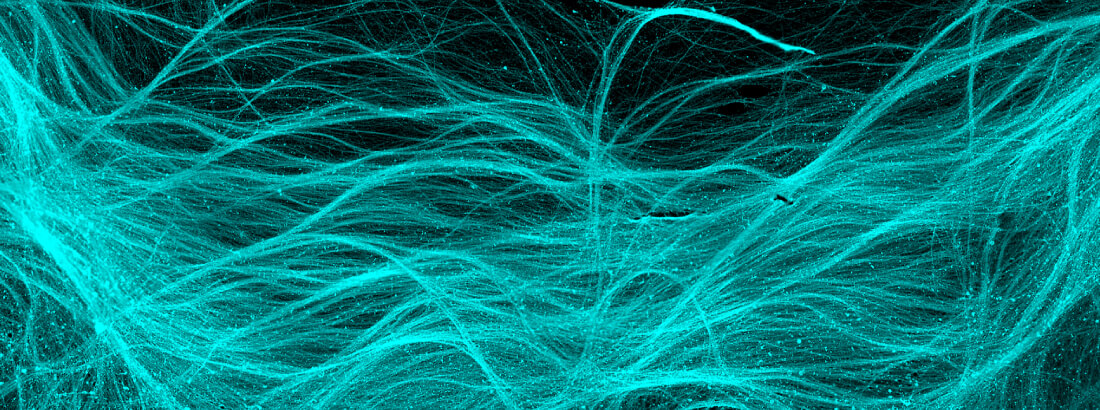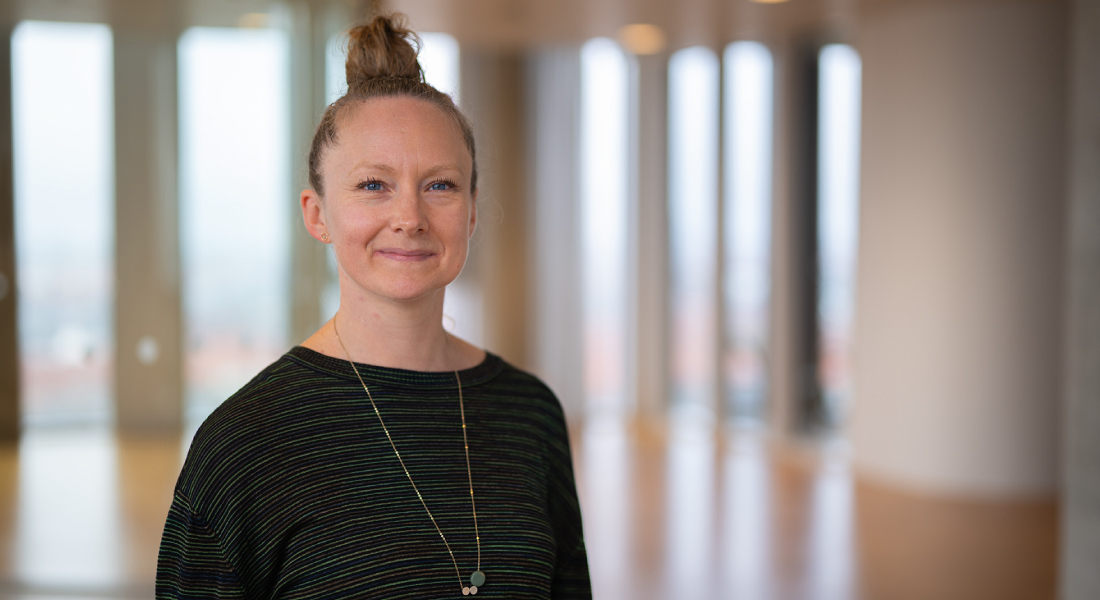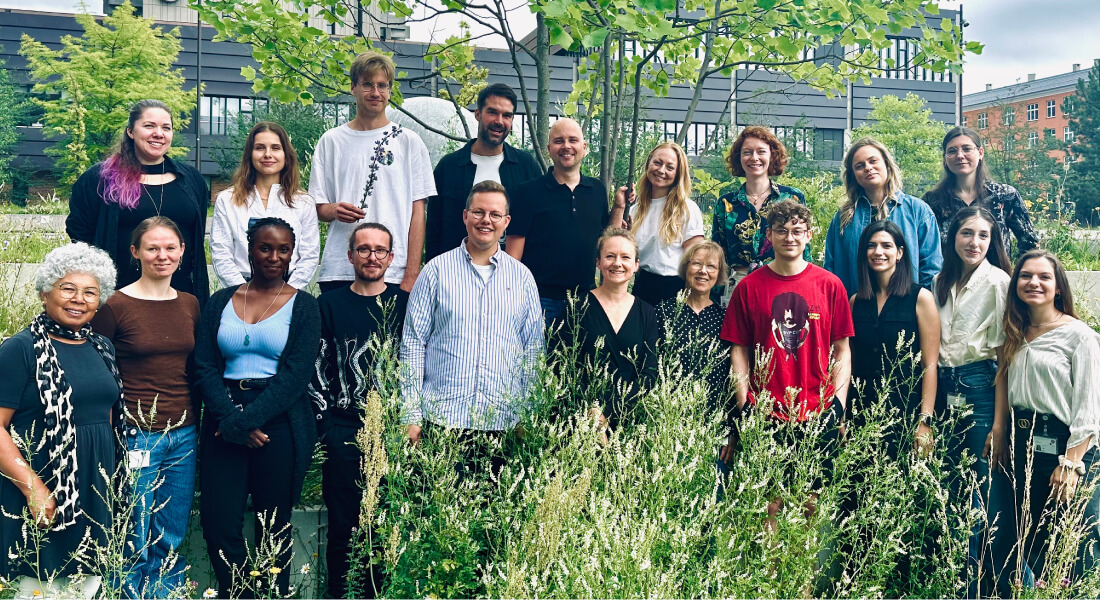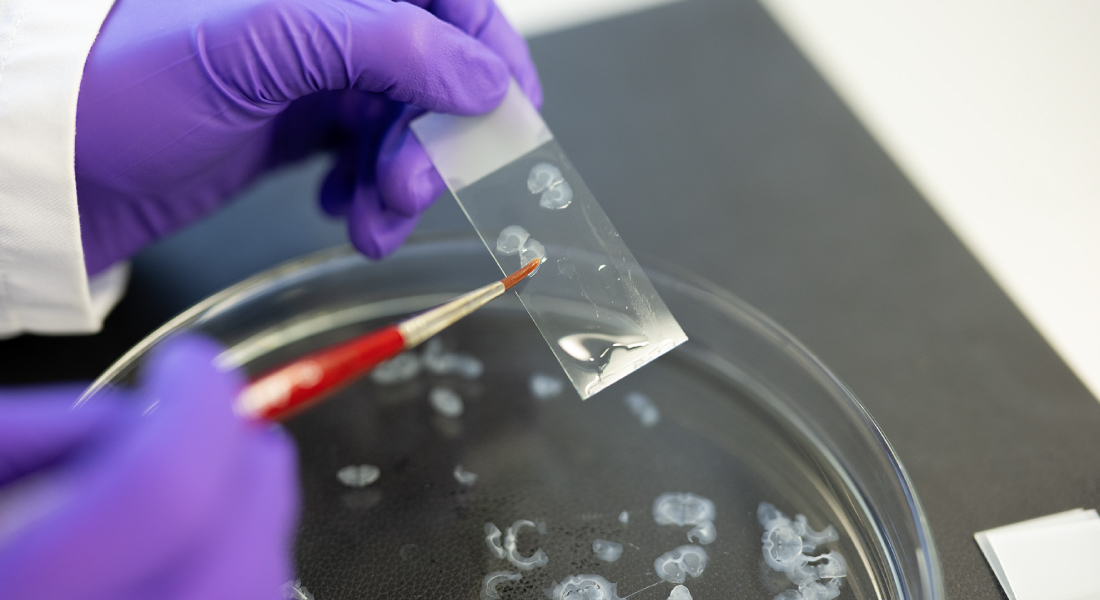Human neural development - Kirkeby Group
The aim of the Kirkeby Group is to develop novel stem cell transplantation therapies for neurodegenerative diseases as well as to use the stem cells as a tool to understand the pathogenesis of brain disorders.

The human brain is a highly complex structure, consisting of thousands of different subtypes of neural cells; each of which fulfil a specific function in the brain network. However, experimental evidence regarding the development of the human brain is highly restricted due to the limited availability of fetal brain tissue.
In the Kirkeby lab, we apply advanced human stem cells models to understand how the multitude of human neuronal subtypes are formed during embryo development, and we apply this knowledge to produce and study human neurons in the lab for disease modelling, drug screening and transplantation therapies towards brain diseases.
Mapping human neural subtype identities in a microfluidic model of the human neural tube (the MiSTR model)
Through microfluidic engineering techniques, we expose hESCs to morphogenic gradients in vitro, thereby building a microenvironment in which the stem cells are patterned into structures resembling the early stages of the rostral-to-caudal regionalised human neural tube. With this we apply single cell RNA sequencing to identify the unique molecular signatures of different regional human neural subtypes and dissect the trajectories underlying the regionalisation and subregionalisation of the brain during embryo development.
Generating human hypothalamic neurons for studying neuronal control of appetite, metabolism and sleep
Access to functional human hypothalamic neurons is of great interest to pharma, biotech and academia for use in disease modelling, drug screening and cell replacement therapies. However, protocols for generation of subtype-specific hypothalamic neurons are still suboptimal. In this project, we generate protocols for subtype-specific differentiation of hESCs into different subregions of the hypothalamus for molecular studies. We focus in particular on neuronal subtypes which are important for the regulation of appetite, metabolism and sleep, and we investigate the use of HCRT neurons as a possible transplantation therapy for narcolepsy.
Generating human basal forebrain cholinergic neurons for treatment of dementia
Neurodegenerative disorders such as Parkinson’s Disease and Lewy body disease are associated with the loss of basal forebrain cholinergic neurons, which can lead to memory loss and dementia. In this project, we develop protocols for generating cultures of human basal forebrain cholinergic neurons from stem cells. Through animal models, we assess the potential of these cells to be used as a transplantation cell therapy for treatment of cognitive deficits. This project is partly funded by the EU H2020 consortium NSC-Reconstruct.
Developing in vitro stem cell models of Parkinson’s Disease and Alzheimer’s disease
Recent studies in the field of neurodegenerative diseases has put increased focus on the role of neuroinflammation and glial in the pathogenesis of disease progression. Through several projects, we develop models of neuropathology including neuroinflammation in PD and AD through the use of complex in vitro models containing human neurons, astrocytes and microglia. The aim of these models is to perform high-throughput drug screening to identify novel diease-modifying targets. Part of this work is funded as a Michael J Fox Foundation/ASAP Research consortium
Studying schizophrenia pathology in the dish
Through a collaborative research project with Prof. Kasper Lage and Prof. Thomas Werge, we use stem cell models of human inhibitory interneurons and cortical excitatory neurons to study the neuronal pathology underlying schizophrenia in monogenic and polygenic forms of the disease. This project is funded by the Lundbeck Foundation.
STEM-PD: A clinical trial of developing a stem cell therapy for treatment of Parkinson’s Disease
Through our work at Lund University, we have in a longstanding collaboration together with the lab of Malin Parmar developed a cell transplantation therapy to replace the dopamine neurons which are lost in the brains of Parkinson’s Disease patients. This work has resulted in a clinical stem cell product (STEM-PD), which has been approved by the regulatory authorities, and which was the first pluripotent stem cell product to enter clinical trial for brain transplantation in the EU. Read more here: https://stem-pd.org/.
Full list of publications by Agnete Kirkeby
Selected publications
- Abay-Nørgaard Z, Müller AK, Hänninen E, Rausch D, Peeters S, Christiansen JB, Schörling AL, Li Y, Salvador A, Piilgaard L, Nikulina V, Rathore GS, Kajtez J, Pers T, Kirkeby A. Generation of human hypothalamic appetite-regulating neurons and tanycytes from stem cells. BioRxiv 2024, doi: 10.1101/2024.07.11.603039
- Rifes P, Kajtez J, Christiansen J, Schörling, Heuer A, Wolf DA and Kirkeby A. Forced expression of LMX1A induces dorsal neural fates and disrupts patterning of human embryonic stem cells into ventral midbrain dopaminergic neurons. Stem Cell Reports 2024, doi: 10.1016/j.stemcr.2024.04.010
- Christiansen JR and Kirkeby A. Clinical Translation of Pluripotent Stem Cell-Based Therapies: Successes and Challenges, Development 2024, doi: 10.1242/dev.202067
- Kirkeby A, Nelander J, Hoban DB, Rogelius N, Bjartmarz H, Novo Nordisk Cell Therapy R&D, Storm P, Fiorenzano A, Adler AF, Vale S, Mudannayake J, Zhang Y, Cardoso T, Mattsson B, Landau AM, Glud AN, Sørensen JC, Lillethorup TP, Lowdell M, Carvalho C, Bain O, van Vliet T, Lindvall O, Björklund A, Harry B, Cutting E, Widner H, Paul G, Barker RA, Parmar M. Preclinical quality, safety, and efficacy of a human embryonic stem cell-derived product for the treatment of Parkinson’s Disease, STEM-PD. Cell Stem Cell 2023, doi: 1016/j.stem.2023.08.014
- Rifes P, Isaksson M, Rathore GS, Aldrin—Kirk P, Møller OM, Barzaghi G, Lee J, Egerod KL, Rausch DM, Parmar M, Pers TH, Laurell T and Kirkeby A. Modeling neural tube development by differentiation of human embryonic stem cells in a microfluidic WNT gradient. Nature Biotechnology 2020, DOI: 10.1038/s41587-020-0525-0
- Nolbrant, S., Heuer, A., Parmar, M., and Kirkeby, A. (2017). Generation of high-purity human ventral midbrain dopaminergic progenitors for in vitro maturation and intracerebral transplantation. Nature Protocols 2017, doi:10.1038/nprot.2017.078.
- Kirkeby, A., Nolbrant, S., Tiklova, K., Heuer, A., Kee, N., Cardoso, T., Ottosson, D.R., Lelos, M.J., Rifes, P., Dunnett, S.B., Grealish, S., Perlmann, T., and Parmar, M. (2017). Predictive Markers Guide Differentiation to Improve Graft Outcome in Clinical Translation of hESC-Based Therapy for Parkinson's Disease. Cell Stem Cell 2017, doi:10.1016/j.stem.2016.09.004.
- STEM-PD consortium and Novo Nordisk A/S: Conducting a clinical trial with a pluripotent stem cell product for treatment of Parkinson’s Disease (stem-pd.org)
- Malin Parmar (Lund University, SE): Improving dopamine cell products for treatment of Parkinson’s Disease
- Kasper Lage (Broad Institute, USA) and Thomas Werge (Copenhagen, DK): Investigating key protein networks in schizophrenia
- Barbara Treutlein (ETH Zurich, Basel, CH): Single cell mapping of a microfluidic morphogenic model of the human neural tube.
- Johan Jakobsson (Lund University, SE) and Roger Barker (Cambridge University, UK): Studying the role of transposable elements in Parkinson’s Disease (ASAP consortium)
- Tune Pers (University of Copenhagen, DK): Studying human hypothalamic neurons from stem cells through single cell bioinformatics
- Bioneer (Copenhagen): Improving neuron-glial co-culture systems for modelling neurodegenerative Disease
- NSCReconstruct EU consortium: Developing second-generation cell products for neurodegenerative diseases
- Novo Nordisk Foundation, Hallas Møller Emerging Investigator fellowship
- Independent Research Fund Denmark, Sapere Aude Research Leader fellowship
- EU Horizon 2020 Research Consortium NSC-Reconstruct
- Michael J Fox Foundation/ASAP, Research consortium
- Lundbeck Foundation, Collaborative project & Postdoc Fellowship
- Bioneer, DigitSTEM project
- Knut and Alice Wallenberg Foundation, WCMM Fellowship
- Human pluripotent stem cells: Culturing and neural differentiation of human pluripotent stem cells to subtype-specific regionalised neural cells.
- 2D and 3D stem cell models: Generating mixed neuronal and glial 2D and 3D models for studying pathology of neurodegenerative diseases
- Microfluidic cell culturing: Development and use of microfluidic culturing devices to control regionalisation of human stem cells during differentiation
- Gene editing: Generation of CRISPR/Cas9 reporter cell lines, knockout lines and lentiviral constructs for transgene exression
- Bioinformatics: High-throughput qRT-PCR analysis and Single cell RNAsequencing using the 10X Chromium platform
- In vivo xenotransplantation: Rat models for stereotactic xeno-transplantation of human neural cells
- Imaging: Confocal fluorescence microscopy, live imaging and immunohistochemistry

Kirkeby Group is LEAF bronze certified on their sustainability actions.
Learn more about Kirkeby Group
In the media
Digital media
- Danish Broadcast TV | Modelling human brain development in the dish (in Danish)
- Arte Television | Documentary on Parkinsons - Research brings hope
Print media
- Lund University | press release on 'First patient receives milestone stem cell-based transplant for Parkinson’s Disease'
- The Daily Beast | article on stem cell therapy for Parkinson’s Disease
- Politiken | article on human trials (in Danish)
- World Parkinson Congress | blog on 'Stem Cells for Parkinson’s: Hype or Hope?'
- The Guardian | article on 'Radical new therapy for Parkinson’s will use stem cell transplants'




